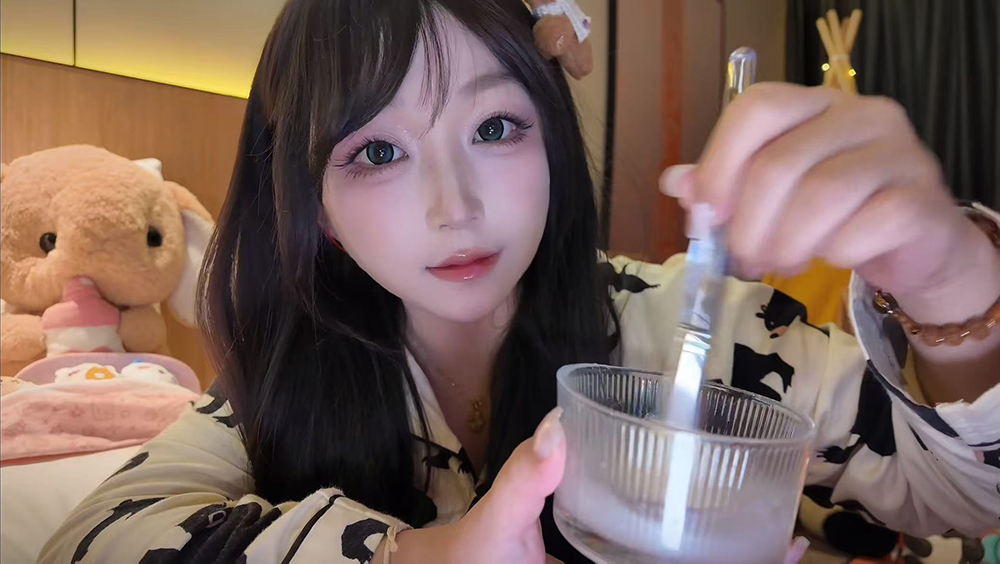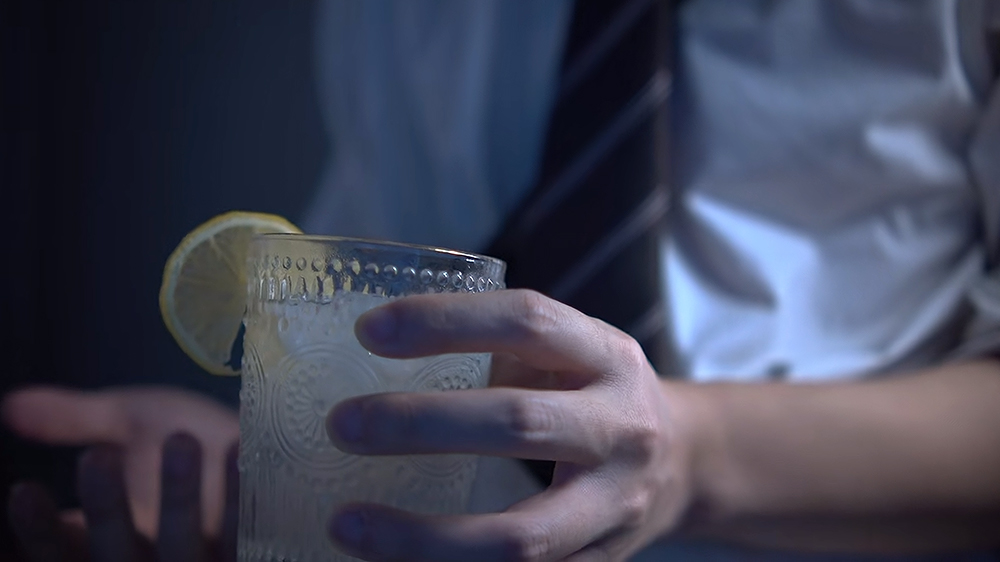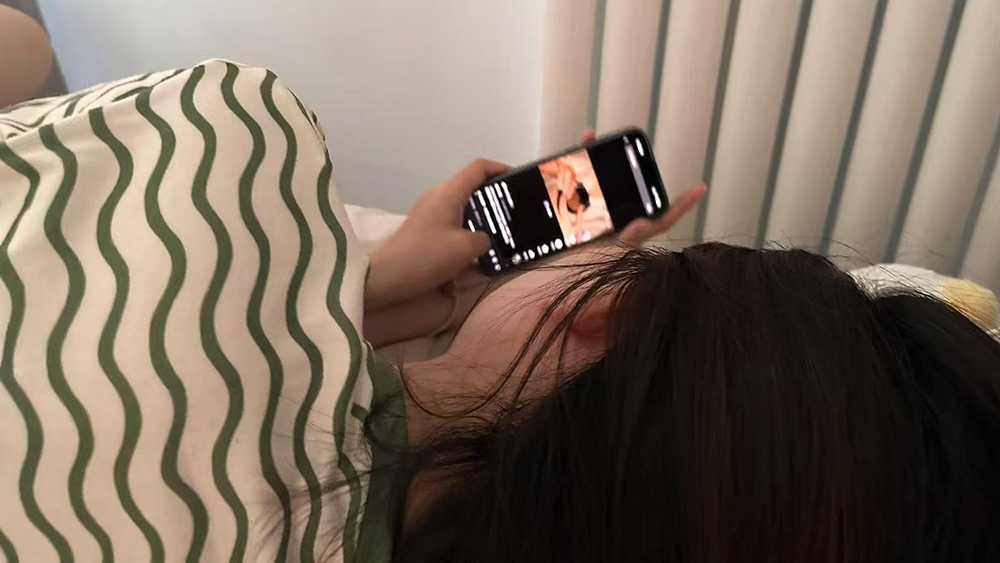More young people now rely on whispering videos from online creators to fall asleep. But is this virtual intimacy making real relationships harder?

Near midnight, 19-year-old college student Rui Lin lay in bed, put on her headphones and opened a familiar video. In the video, a girl is leaning against the bedside and whispering softly, “Are you exhausted today? Let me clean your ears for you.” She picked up the cotton swab and moved slowly towards the camera, as if she were really sitting beside you.
It was the video she watched every night before going to bed. It was titled ASMR Girlfriend Role-Playing, and it had been viewed over 200,000 times. The girl in the video not only comforts you but also pretends to help remove your makeup, clean your ears, and even feed you snacks.
“I really feel that I’m being taken care of and accompanied,” said Rui. “It makes me imagine that there’s really someone speaking to me this gently, someone who understands and accepts me, just like the person in the video.”
This kind of video is Autonomous Sensory Meridian Response (ASMR). It mainly works through gentle whispers, tapping, brushing to bring a tingling sensation and relaxation on the scalp, helping people fall asleep. According to Dr Craig Richard, the founder of the ASMR University website, “Biological research shows that ASMR can activate specific brain regions and induce brain waves related to relaxation.”
In recent years, ASMR has rapidly become a new trend on YouTube and TikTok. According to 2025 data, ASMR became one of the most popular search words on YouTube, with a global monthly search volume of approximately 16.8 million.
To meet growing demands form audience, more creators have begun to appear on screen, taking on roles such as romantic partners, friends, or therapists, and use the camera to craft a sense of being cared for. Dr. Craig Richard said in a 2024 interview: “ASMR works because it simulates intimate and gentle interactions in reality, and these positive attentions themselves can bring emotional comfort.”

A video on YouTube titled “ASMR Boyfriend Cuddles You to Sleep” has received over 2.76 million views and 34,000 likes. Many people commented below: “This made me cry because I miss feeling safe, secure, and at peace in someone’s arms.” “I yearn for this love.”
What makes these videos so immersive to the audience is that they not only provide emotional comfort, but also consciously create a real and tender intimacy through the details of the script, sound, scene.
According to an instructional article on SpicyASMR, the key to creating a boyfriend ASMR video is an empathetic script and closeness to everyday situations. For instance, creators would design scenarios like waking you up in the morning or telling bedtime stories to simulate the most ordinary yet reassuring interactions between lovers.
Meanwhile, appropriate sound design such as soft whispers, the sound of rain in the background, and the rustling of the bed sheets further enhances the sense of immersion. It is precisely these meticulous settings that make the audience feel as if they were in a real relationship.
However, some experts have also begun to worry whether this highly simulated intimate experience will lead people away from establishing real relationships.
A study argued that spending a large amount of time on mediated intimate experiences may reduce the time spent face-to-face with real close people, thereby affecting happiness. So, if people get used to seeking comfort from videos, the motivation to build relationships in reality may be weakened.

But many viewers do not think so. For instance, Rui, who likes to fall asleep to girlfriend role-playing videos, knew that the plot in the video was not realistic. “I won’t take it too seriously because there’s no such perfect person in reality,” said Rui. But this idealized tenderness was hard for her to resist.
Especially after the pandemic, such demands have become increasingly prominent among young people. Many people have become lonelier due to long-term solitude and reduced social interaction. To fill this gap, they have begun to actively seek alternative intimate relationships. Some people even project their emotions onto virtual lovers or AI programs.
This phenomenon is particularly prominent among the younger generation. A survey by a dating platform in the United States shows that 16% of single people, and one-third of Generation Z, regarded AI as their romantic partner.
In addition to the desire for love, for Mei, this kind of ASMR video is her fantasy about family relationships. 26-year-old Mei has always been fond of watching mother role-playing videos. In this type of video, the creator usually plays the role of a mother to take care of her child, using a gentle tone while combing your hair and giving you medicine.
She admitted that she was a left-behind child when she was young and seldom stayed with her mother. It is precisely because she lacked her mother’s company in her childhood that she is more easily moved by such scenes of mother roles. “I always imagine the creators in the video as my mother. Sometimes I feel that in another world, I’m really being treated so gently,” said Mei.
When creators design characters such as lovers and friends, they often present them as an ideal partner or intimate relationship image to satisfy the audience’s imagination, thereby also gaining higher attention and feedback.

Dingdang, a 26-year-old new blogger, tried making his first popular role-playing videos at the suggestion of his fans. The response was surprisingly good. The number of likes is ten times that of the previous video.
The video is named “The Deskmate Who Has a Crush on You”. In the camera, he moved closer to you and asked, “Did you like the breakfast I brought you?”
Dingdang believes that what the audience is seeking is something they haven’t obtained in reality but are eager to have. “Some people may not have a considerate partner in real life, so they think that the character in the video is the ideal state,” he said.
Although the characters offer the audience the experience of companionship, the creators themselves do not consider themselves emotionally involved. “Perhaps I did accompany some people through their nights,” said Dingdang, “but it was actually the character in the video who was with them, not myself.”
He drew a clear line between himself and the character, and never regarded these videos as a genuine relationship. But when the audience seeks emotion while the creators keep a distance, can such a relationship still be regarded as a form of companionship?
In fact, the emotional connection that some viewers want does not require interaction and carries no burden. Yutong Han, 25, watches ASMR more than half an hour before going to bed every day. But she never joins creators’ fan groups or interacts through private messages.
“Once there’s too much interaction and too much emotional investment, this relationship loses its original flavor,” said Yutong, “I don’t want it to get complicated.”
In psychology, this kind of relationship is called parasocial relationships – the audience unilaterally invests their emotions. Even without real interaction, they can still feel understood and accompanied.
The reason why this kind of relationship has become more popular is the difficulty of communicating in real life. A 2024 survey revealed that approximately 52% of respondents had established quasi-social relationships with YouTubers, with 36% indicating a sense of closeness. Such a relationship can offer support and acceptance without worrying about the feeling of rejection in reality.
A 2023 poll in the UK shows that more than half of men aged 16 to 24 and 40% of women believe that dating now is harder than in their parents’ generation. In addition, nearly 40% of young people say they often or very often feel lonely. The main reason is that it’s difficult to maintain friendships.
Where real-life interactions are becoming increasingly exhausting, ASMR has emerged as a low-risk way to get emotional comfort. Just turn on the video and put on headphones, and you can evoke the feeling of companionship.
But some psychologists have issued warnings about this phenomenon. According to a 2019 report, American clinical psychologist Alexandra R. Lash said that excessive viewing of boyfriend role-playing type ASMR videos may lead people to have “unrealistic and idealized” expectations of their partners.
Stanford psychologist Dr. Fleck added that the subconscious message behind the videos is that “you can’t sleep until someone takes care of you,” which runs counter to psychology’s emphasis on self-care. If people rely on this kind of video for a long time to achieve emotional relaxation, it may weaken their ability to cope with stress through self-regulation in daily life.
However, this potential emotional dependence is not limited to lover role-playing videos. Some viewers prefer other types of role-playing videos. Tingting Hu, 24, usually prefers to watch simulated makeup content. Makeup videos make her feel as if she is being served one-on-one, with the other person’s attention only focused on her. This feeling of being taken care of attentively makes her feel very at ease. She clicks on it every night before going to bed.
‘Even if I don’t need it to help me sleep anymore, I still want to watch it. “If I don’t look, I always feel that something is missing today,” said Tingting. “I know I’m already very dependent, but it’s nice to know that I have a place to relieve my stress.”

Although there are concerns that people might get addicted to the virtual relationships constructed by videos, not all researchers hold this view.
According to Dr. Craig Richard, “the ASMR experience triggered by video is more like a supplement rather than a substitute. Just as treadmills can serve as a supplement to daily exercise, ASMR videos can also offer additional emotional regulation beyond our existing real social interactions.”
He said, “The majority of viewers still have social interactions in reality and will not completely sever ties with the real world by watching videos. On the contrary, this online experience can help them better cope with stress and improve their mood.”
From the perspective of the creators, when the audience regards them as digital companions, it is actually a form of affirmation. “I don’t think there’s any problem,” said Dingdang. “Some viewers are willing to use you as their digital companion, which can be regarded as their recognition of you, because your performance of the plot has indeed drawn the audience into the story.”
Although there is still controversy over whether virtual companionship weakens real relationships, for many young people, it at least meets emotional needs that cannot be obtained in real life.
For Rui, who has never been in a relationship before, such a virtual scene is her expectation for an intimate relationship. “I really hope that there is someone in reality who can be as gentle and tolerant to me as in the video,” said Rui.